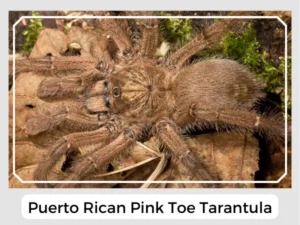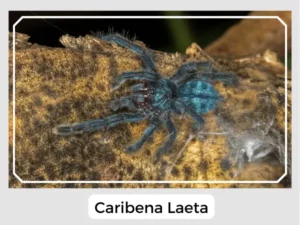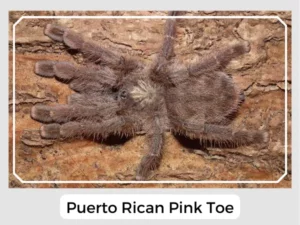The Puerto Rican pinktoe tarantula is a special spider found only in the Americas. Known for its unique appearance, especially when young, many collectors and spider lovers want to have one. Here, we will share interesting facts about this fascinating creature.

Photo Credit: Craig Mackay

Photo Credit: Alfredo Colon
Females lay the eggs inside sacs made of webbing.
The spiderlings have a unique neon-blue coloration, which eventually fades when they reach adulthood.
These spiders do not use webbing to catch prey, instead spinning silken threads to detect intruders.
Yes, Puerto Rican Pinktoe Tarantulas have venom, but it’s generally not harmful to humans and is used to subdue their prey.
Yes, they can bite if they feel threatened. However, their bite is usually not severe for humans and is similar to a bee sting in pain level.
The Puerto Rican Pinktoe tarantula plays a crucial role in the balance of the ecosystems it inhabits. As a predator, it helps regulate the populations of insects, contributing to the control of pests that could otherwise have damaging effects on local flora. Intriguingly, their hunting method, which does not rely on webbing to ensnare prey but rather uses silk as a sensory tool to detect the presence of intruders, demonstrates the spider’s adaptation to an arboreal lifestyle.
The behavior of the Puerto Rican Pinktoe is as remarkable as its physical appearance. These spiders are known for their agility and the ability to leap from branch to branch in their arboreal habitats. Their social behavior is also of interest; unlike many tarantula species that are solitary, the Puerto Rican pinktoe can exhibit social tendencies, with juveniles often cohabitating peacefully.
Natural Predators: Despite their venom and intimidating appearance, Puerto Rican Pinktoe tarantulas have their share of natural predators. Birds, especially larger species, are known to prey upon them. In addition to avian predators, other larger spiders and certain mammals can also pose a threat to them, especially to the more vulnerable spiderlings.
Prey-Predator Dynamics: The diet of the Puerto Rican Pink toe consists primarily of insects such as cockroaches, crickets, and grasshoppers. The dynamic between them and their prey is a fascinating display of the food web in action. The tarantula’s predation methods reflect its agility and the effectiveness of its venom, which enables it to quickly immobilize prey, demonstrating the intricacies of prey-predator interactions in their natural habitats.
Relationship with Humans: Humans have shown a great interest in the Puerto Rican Pinktoe tarantula, particularly in the pet trade. While their venom is not typically harmful to humans, and their bite comparable to a bee sting, it is crucial for keepers to handle them with care to avoid stress-induced reactions. Moreover, their presence in human-populated areas can be beneficial as they help control insect populations, acting as a natural pest management system.

Photo Credit: Craig Mackay
| Other names | Puerto Rican Tree Spider |
| Lifespan | Males: 3-5 years, Females: 8-13 years |
| Distribution | Cuba, Puerto Rico, and the US Virgin Islands |
| Habitat | Arboreal |
| Diet | Cockroaches, crickets, and grasshoppers |
In summary, the Puerto Rican Pinktoe tarantula is not only a creature of beauty but also an integral part of its ecosystem.
The Puerto Rican pinktoe tarantula is a special spider found only in the Americas. Known for its unique appearance, especially when young, many collectors and spider lovers want to have one. Here, we will share interesting facts about this fascinating creature.

Photo Credit: Craig Mackay

Photo Credit: Alfredo Colon
Females lay the eggs inside sacs made of webbing.
The spiderlings have a unique neon-blue coloration, which eventually fades when they reach adulthood.
These spiders do not use webbing to catch prey, instead spinning silken threads to detect intruders.
Yes, Puerto Rican Pinktoe Tarantulas have venom, but it’s generally not harmful to humans and is used to subdue their prey.
Yes, they can bite if they feel threatened. However, their bite is usually not severe for humans and is similar to a bee sting in pain level.
The Puerto Rican Pinktoe tarantula plays a crucial role in the balance of the ecosystems it inhabits. As a predator, it helps regulate the populations of insects, contributing to the control of pests that could otherwise have damaging effects on local flora. Intriguingly, their hunting method, which does not rely on webbing to ensnare prey but rather uses silk as a sensory tool to detect the presence of intruders, demonstrates the spider’s adaptation to an arboreal lifestyle.
The behavior of the Puerto Rican Pinktoe is as remarkable as its physical appearance. These spiders are known for their agility and the ability to leap from branch to branch in their arboreal habitats. Their social behavior is also of interest; unlike many tarantula species that are solitary, the Puerto Rican pinktoe can exhibit social tendencies, with juveniles often cohabitating peacefully.
Natural Predators: Despite their venom and intimidating appearance, Puerto Rican Pinktoe tarantulas have their share of natural predators. Birds, especially larger species, are known to prey upon them. In addition to avian predators, other larger spiders and certain mammals can also pose a threat to them, especially to the more vulnerable spiderlings.
Prey-Predator Dynamics: The diet of the Puerto Rican Pink toe consists primarily of insects such as cockroaches, crickets, and grasshoppers. The dynamic between them and their prey is a fascinating display of the food web in action. The tarantula’s predation methods reflect its agility and the effectiveness of its venom, which enables it to quickly immobilize prey, demonstrating the intricacies of prey-predator interactions in their natural habitats.
Relationship with Humans: Humans have shown a great interest in the Puerto Rican Pinktoe tarantula, particularly in the pet trade. While their venom is not typically harmful to humans, and their bite comparable to a bee sting, it is crucial for keepers to handle them with care to avoid stress-induced reactions. Moreover, their presence in human-populated areas can be beneficial as they help control insect populations, acting as a natural pest management system.

Photo Credit: Craig Mackay
| Other names | Puerto Rican Tree Spider |
| Lifespan | Males: 3-5 years, Females: 8-13 years |
| Distribution | Cuba, Puerto Rico, and the US Virgin Islands |
| Habitat | Arboreal |
| Diet | Cockroaches, crickets, and grasshoppers |
In summary, the Puerto Rican Pinktoe tarantula is not only a creature of beauty but also an integral part of its ecosystem.